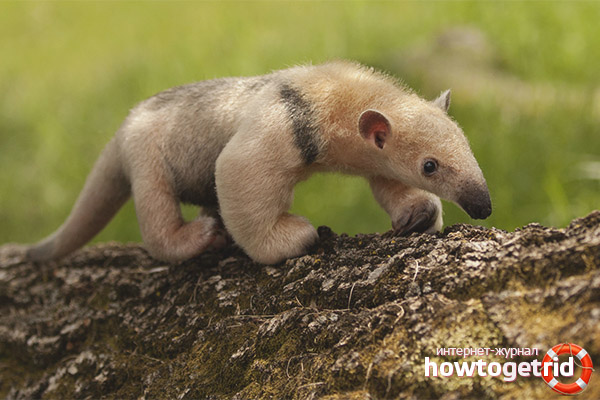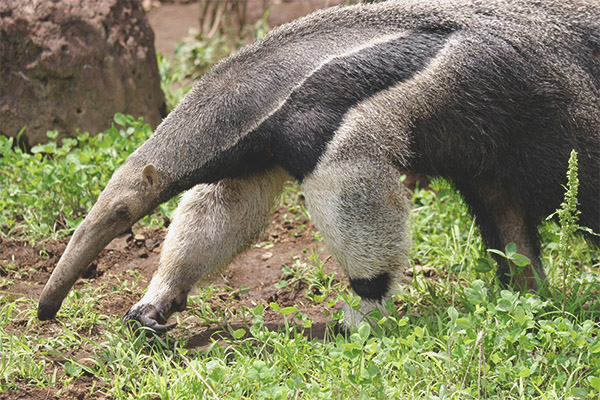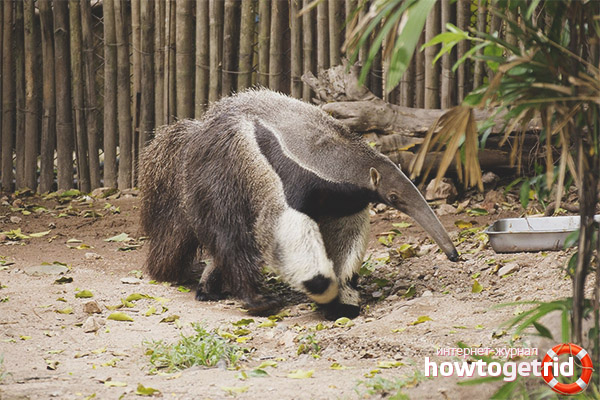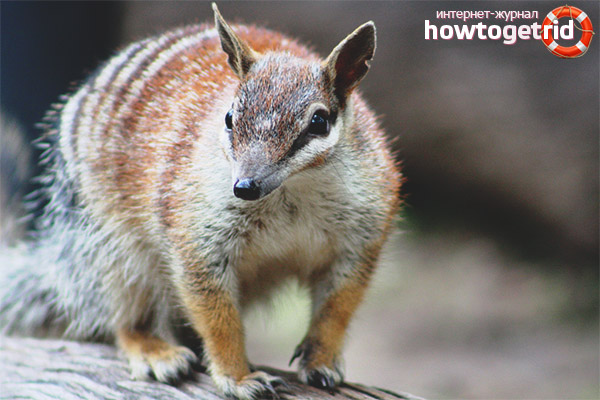The content of the article
Our vast planet certainly does not belong to the human species alone. It is inhabited by colorful, gorgeous flowers and trees, impressive by the variety of sea and river inhabitants, large and small birds. And it always surprises with how extraordinary the animal world is. Among the most unique and unusual animals is an anteater.
Appearance Description
This animal is a mammal, belongs to the order of incomplete teeth. Such a dry description about him can be found in some encyclopedia. But in reality, this is an incredibly interesting beast, and the perception of an ordinary person is not yet quite accustomed to it. Mostly the anteater lives in the forests and shrouds of America - its central and southern parts.
The anteater most actively conducts its activities at night, and during the day prefers to sleep, hiding with its own tail and curled up in a cozy lump. Animals that have a small size usually climb high on trees to avoid encounters with predators, while large and giant animals easily fit to spend the night right on the ground. They don’t worry about meeting with their enemies, as for protection a large anteater has muscular and strong legs up to ten centimeters long, ending in sharp claws.
Externally, the animal looks very specific and peculiar. Strong limbs, small, rather elongated head, small eyes and ears. But the muzzle of this animal is elongated, pointed, at the end of which is a tiny mouth, in which there are no teeth.
Despite the fact that this animal has no teeth, it naturally has a strong and elongated tongue that is longer than the same organ in a giraffe and even an elephant. The width of the tongue of the anteater does not exceed one centimeter, and the length reaches 60 cm. In addition, due to the glands secreting saliva, the tongue is wetted and becomes extremely tenacious and sticky.
It is noteworthy that this strong organ can move with extraordinary speed - the anteater can move them up to 150 times within a minute. The palate of this animal is covered with horny fine bristles, which allows it to easily scrape small insects from the tongue sticking to it.
An anteater has a very muscular stomach, it processes food into it using sand and tiny pebbles. The animal swallows such a specific mixture on purpose. The diet of the anteater includes mainly termites and ants. However, the anteater is not a fastidious animal. If he fails to find an anthill, he will calmly eat small insects, worms, and sometimes even ordinary berries.
This species is subdivided into a large (or giant) anteater, the body length of which may exceed 120 cm, the average - 70 cm, and the dwarf - no more than 55 cm.
Giant anteater
This animal is the largest among the representatives of this species. What is only one of his tail, which is more than one meter in length. On the front limbs of the animal there are four fingers, on which are frightening huge claws.Just the same claws and give such a characteristic gait of this animal - it is forced to turn them, stepping on his paw, and an anteater leans at a step on the outer part of his wrist.
Thus, the anteater can run rather badly. Rather, this beast will fearlessly engage in battle with the enemy, rather than turn to flee. In order to frighten the predator that attacked him, the anteater rises into a "fighting" stance - rises on its hind limbs and awesomely raises its front paws anteriorly. With his claws, he can deliver a lot of problems to his enemies.
He has a rather hard coat, on different parts of his torso, wool is different in length. In the neck and head it is rather short, the body is covered with medium-sized wool, and on the tail it is as long as possible - up to 40-50 cm. The habitat of a large anteater falls only in the south of America. He prefers to choose places to live in, distant from human settlements. There he can actively live in the day and night. If the animal has to make a home near people, then it leaves its shelter only at night.
Using its massive, crowned with claws, paws, the animal can easily agitate and pierce the anthills, to brake termitaries. In such anteaters, the mating season begins in spring and autumn. After mating, the female produces one baby, whose weight is approximately one and a half kilograms. The gestation period lasts up to six months, but an independent anteater becomes a couple of years old. Up to this age, he lives with his mother.
Medium Anteater (Tamandois)
This is a special genus of such animals, because they have five fingers on their hind limbs. Mostly, this anteater lives on the trunks and branches of trees, because even with the tail, its length can barely reach one meter.
Despite the apparent resemblance to his giant brother, Tamandua is half the size of him. The main difference between them lies in the size and tail. In the average anteater, the tail is rather thick, powerful, helping it move freely and freely through the trees.
In tamandua, which dwells in the southeast, the wool is usually yellow-white, the coat on the back is black, the muzzle is also black, and ringlets are located around the eyes.His young, however, only at the age of two acquire the color of a mature individual, and until this moment all are covered with yellow-white wool.
Representatives of this species who live in the northwestern part, on the contrary, are painted uniformly - in dark brown, off-white or completely black.
This animal prefers to inhabit the same areas where the giant anteater lives, but in general its habitat is slightly wider, reaching the territory of Peru. Usually lives in forests, on small edges or thickets of bushes. It can fit in for the night not only on the surface of the earth, but also on the trunks of trees.
Before you go to sleep, the anteater grabs its tail by the chosen strong branch, then rolls up into a lump and covers its muzzle with its large paws. For feeding, thamandua usually gathers for itself ants, in particular, those that live in trees. It is noteworthy that at the moment of great anxiety and excitement this animal begins to produce an extremely specific and unpleasant odor.
Silk anteater (dwarf)

This species of anteater is completely different from its larger counterpart.The size of his body hardly reaches 40 centimeters, and this is in view of the tail. This animal also has an elongated muzzle and a powerful strong tail, which allows it to dwell in the trees, almost without going down to the surface of the earth. The coat of the animal gives a golden hue, silky to the touch, which formed the basis of the subspecies name.
Despite its compact dimensions, this animal is not fearful, prefers to fight with its enemies, meeting them with a warlike stance. The anteater uses its powerful paws with sharp claws to attack and strike. Despite this, he has a lot of rivals in the natural environment, who are not averse to eating, so the anteater prefers to be active at night and practically does not sink to the surface of the earth.
In these animals, the male and female converge only in the mating season, when they begin to mate, and then raise the offspring produced. After the baby is born and the first few days dwells in the hollow of a tree, he sits on the back of the male or female.
Both parents treat their baby equally carefully, sensitively and carefully.
Features nambat or marsupial anteater
Also, the so-called marsupial anteater deserves special attention. This extraordinary animal belongs to the order of marsupial predators. The habitat of this animal is in Australia. Those animals that live in the west of this continent are distinguished by their back adorned with thin black stripes, and the anteaters living in the east are monotonically colored. This is a pretty tiny animal, whose body length almost reaches 25-27 centimeters, and its mass does not exceed half a kilogram. Along with other representatives of the species, the face at the nambat is elongated, its shape is sharp, the tongue is elongated and rather thin.
The main difference from other counterparts in the marsupial anteater is teeth, and there are quite a lot of them. It is surprising that it is among the most toothy predatory animals - a nambat can have up to 52 teeth. However, they are not the best quality, small, weak and randomly located. But the eyes and ears are rather large, with sharp claws on their paws.
Curiously enough, by definition this anteater cannot be called marsupial, since it does not have a bag as such.An unusual feature is that several calves, produced by the female into the world, can tenaciously cling to her nipples, and then hang on the mother in this way. No other animal on the planet can boast such a skill.
Anteater as a domestic animal
Of course, to your pet should be treated carefully, without showing aggression. In the opposite case, the animal will have to defend. In order for his dangerous claws not to cause inconvenience and injuries to its owner, experts advise cutting them twice a week.
To keep an anteater at home is quite difficult, it turns out to be a serious hassle. He needs to provide all the conditions, to organize an open-air cage, which will have a lot of swings, various hammocks, ropes.It is worth remembering that the anteater is quite gentle, so the temperature in the room should not fall below 25 degrees Celsius. Living at home, the anteater will gladly eat a variety of vegetables, dairy products, minced meat, fruit and cheese. But it is better not to offer them sweets, it can be harmful for them.
Video: Anteater (Myrmecophagidae)













To send